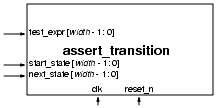
|
Parameters:
severity_level
width
property_type
msg
coverage_level
|
Class:
2-cycle assertion
|
Ensures that the value of a specified expression transitions properly from a start state to the specified next state.
assert_transition
[#(severity_level, width, property_type, msg, coverage_level )]
instance_name (clk, reset_n, test_expr, start_state, next_state );
The assert_transition assertion checker checks the expression test_expr and start_state at each rising edge of clk to see if they are the same. If so, the checker evaluates and stores the current value of next_state. At the next rising edge of clk, the checker re-evaluates test_expr to see if its value equals the stored value of next_state. If not, the assertion fails. The checker returns to checking start_state in the current cycle (unless a fatal failure occurred)
The start_state and next_state expressions are verification events that can change. In particular, the same assertion checker can be coded to verify multiple types of transitions of test_expr.
The checker is useful for ensuring certain control structure values (such as counters and finite-state machine values) transition properly.
1. The assertion check compares the current value of test_expr with its previous value. Therefore, checking does not start until the second rising clock edge of clk after reset_n deasserts.
assert_no_transition
Ensures that count transitions from 3’d3 properly. If sel_8 is 0, count should have transitioned to 3’d0. Otherwise, count should have transitioned to 3’d4.

|
© Accellera Organization, Inc. 2005 All Rights Reserved. |
Standard OVL V1.1a |